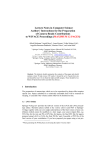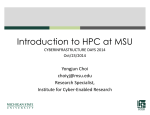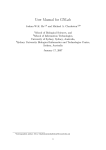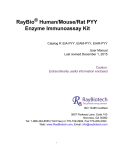Download User Manual
Transcript
GeStoDifferent: a Cytoscape plugin for the identification of Boolean gene regulatory networks describing the stochastic differentiation process Reference manual for version 1.0 Giulio Caravagna Silvia Crippa Alex Graudenzi Giancarlo Mauri Marco Antoniotti ∗ Department of Informatics, Systems and Communication, University of Milan Bicocca, Viale Sarca 336, I-20126 Milan, Italy. 1 Introduction Describing the systems-based characterization of cell differentiation, i.e. the process according to which the progeny of stem cells becomes progressively more specialized by developing in different cell types, is one key goal of both systems and computational biology. By using the dynamical model of cell differentiation described in [30], i.e. a random Boolean network model, we developed a Cytoscape plugin that address this theme. In [30], this approach was proven to reproduce several key properties of the main phenomena. The model is general and is not referred to any specific organism or cell types and is mainly centred on the key concept of emergent dynamical behaviour of Gene Regulatory Networks (GRNs). The model can reproduce, among other important properties: (i) different degree of differentiation, i.e. from totipotent/multipotent stem cells to transit amplifying stages up to to fully differentiated cells [1]; (ii) the important phenomenon of stochastic differentiation, according to which a population of multipotent cells can generate progenies of different types, through a stochastic differentiation process [14, 4, 12]. Instead of focusing on a few “master genes” that would drive the systems, as in one of the commons views, in our model the differentiation properties are ∗ Email: [email protected]. 1 strictly correlated with the dynamical properties of the underlying GRNs and, in particolar, with the stability of their steady states in presence of biological noise. The general idea is that more differentiated cells would wander in a smaller portion of the phase space, because of more refined control mechanism against possible perturbations and fluctuations [11, 16, 9, 10, 7, 15]. Furthermore, the model in [30] allows to relate lineage commitment trees with steady states, hence allowing to match the stable states of a GRN against know differentiation trees (e.g. hematopoietic cells [6]). In this regard, given an input differentiation tree, the plugin allows to search for GRNs (in terms of their Boolean network representation) whose emergent behaviour is in accordance with the input tree (in terms of the expected stability and dynamical trajectory). The plugin is based on a generative approach, i.e. GRNs are randomly created according to user-defined features such as statistical properties and topologies, and a batch process accepts/discard the GRNs matching the input lineage commitment tree. The plugin has been used to find GRNs describing the lineage commitment tree of cell populations in the colonic crypts (i.e. stem, Paneth, Goblet, enterocytes and enteroendocrine) in [8]. In turn, the matched networks have been used to define a multiscale model of crypt development. 2 The model: Noisy Random Boolean Networks Noisy Random Boolean Networks (NRBNs, [23, 25]) are a generalization of classical RBNs [18, 17, 19], a highly abstract and general model of GRN, which was proven to reproduce several biological properties of real networks [27, 28, 26]. Classical RBNs are directed graphs in which nodes represent genes and their Boolean value stands for the corresponding activation (i.e. production of a specific protein or RNA) or inactivation, while the edges symbolize the paths of regulation. A Boolean updating function is associated to each node and the update occurs synchronously at discrete time step for each node of the network, according to the value of the inputs nodes at the previous time step. Formally, a RBN is determined by the two sets {σi ∈ {0, 1} | i = 1, . . . , n} {fi : {0, 1}ki → {0, 1} | i = 1, . . . , n} where the former are n boolean variables and the latter n boolean functions . For any node σi the set {ji , . . . , jki } determines the topology of the network for that node, and consequently for the overall RBN. An execution of an RBN is a series of steps σ(0) → σ(1) → . . . where σ(t) is n dimensional boolean vector termed state of the network. Given that the RBN has a finite state-space (i.e. there exist at most 2n vectors in {0, 1}n ) and the dynamics is fully deterministic, starting from any initial state σ(0) = [σ1 (0), . . . , σn (0)] in at most z ≤ 2n steps the RBN will encounter an 2 Figure 1: Example NRBN and attractors landscape. In left, the NRBN Boolean nodes represent genes (either active or inactive) and the edges regulatory pathways. A specific Boolean function (not shown here) is associated to each node. In right, each node represent a state of the system, i.e. the vector of the activation values of the genes, and the edges display the transitions between the states according to the deterministic dynamics. already visited state σ(z), entering a limit cycle. We term attractor of the RBN the loop starting from σ(z) and the sequence of steps from σ(0) to σ(z) the transient of the attractor. The set of initial condition that end up in a specific attractor σ(z) is its basin of attraction. The Noisy Random Boolean Networks (NRBNs, [30]) was developed because noise plays a major role in numerous cellular phenomena [22, 29, 3, 24, 21, 5] and is supposed to drive the differentiation process [20, 13, 10]. Classical RBN are fully deterministic and, hence, they do not properly account for noise. However, NRBN are built on top of RBN by introducing noise as unexpected jumps between network states. Jumps are determined by flipping genes state (i.e. from active to inactive, and viceversa), possibly in an exhaustive way (i.e. flipping each node in each state of each attractor), and by detecting all the noise-induced transitions between attractors. This allows to draw the so-called Attractor Transition Network (ATN). In this sense, the ATN resembles a stability matrix of the system where its entries determine the probability of switching from one attract to another. NRBNs rely on the assumption that the level of noise is sufficiently low to allow the system to reach its (new or old) attractor before another flip occurs. Noise-resistance, a concept which determines the differentiation level of a cell driven by a NRBN, is implemented by introducing the notion of thresholddependent ATNs. A threshold is used to remove from the ATN those transitions that are considered too rare to occur, i.e. some “jumps” are too rare to happen with a significant probability within the lifetime of the cell. Accordingly, a Threshold Ergodic Set (TES in brief or TESδ when δ ∈ [0, 1] is the threshold) is a set of attractors in which the dynamics of the system continue to transit, in the 3 Figure 2: Example ATN. Each node represents a specific NRBN attractor, inscribed number is the attractor’s length. The edges depict the transitions between attractors that occur after single-flip perturbations of nodes, with the corresponding frequency of occurrence. long run, due to random flips (i.e. noise) or, using the graph theory terminology, a strongly connected component (SCC) in the threshold-dependent ATN. For a formal definition of how these sets are determined we refer the reader to [30, 8]. The biological metaphor. In [30] it is assumed that each TES of a NRBN represents a specific cell type, characterized by a peculiar noise resistance, as indicated by the relative threshold. The degree of differentiation (i.e. highly differentiated against less differentiated) is related to the particular threshold or, in other words, to the possibility for the cell in its attractor to roam in a wider or smaller portion of the phase space (i.e. the size of the TESs which decreases as the threshold increases). At the best of our knowledge, in fact, less differentiated cells (e.g. stem cells) show fewer control mechanisms against noise (e.g. copy errors) and, thus, we characterize them by a smaller threshold allowing them for roaming in a wider portion of the phase space. On the opposite, cells in a more differentiated state present more refined control mechanisms and, consequently, are associated to higher thresholds which actually prevent random fluctuations [21]. As an example, in [8] totipotent stem cells are associated with TESs at threshold 0, cells in a pluripotent or multipotent state (i.e. transit amplifying stage or intermediate state) with TESs with a larger threshold composed by one or more attractors, while completely differentiate cells correspond to TESs with the highest threshold. A generative approach for NRBNs. An apriori choice of a specific NRBN does not guarantee the existence of the TES and thresholds corresponding to the 4 Figure 3: Threshold-dependent ATN and the tree-like TES landscape. The circle nodes are attractors of an example NRBN, the edges represent the relative frequency of transitions from one attractor to another one, after a 1 time step-flip of a random node in a random state of the attractor (performed an elevated number of times). In this case we show three different values of threshold, i.e.: δ = 0, δ = 0.15 and δ = 1. TESs, i.e. strongly connected components in the threshold-dependent ATN are represented through dotted lines and the relative threshold is indicated in the subscripted index. In the right diagram it is shown the tree-like representation of the TES landscape, which determines the differentiation tree for this NRBN. desired differentiation tree (i.e. Figure 2). In addition, this would contradict our choice of not imposing specific detailed assumptions concerning the interaction which drive the modeled phenomena. As a consequence, in GeStoDifferent an acceptance/rejection approach is used to determine which NRBNs match the input differentiation tree. This is sometimes called model sweep and, despite being an undoubtedly costly operation, this is the only possible approach. Once the suitable NRBNs are collected, they can be used to define and analyze more complex models, as done in [8]. Notice that this approach assumes a generic differentiation tree and then can be used for any model which should account for the stochastic differentiation phenomenon. 5 3 Setting up GeStoDifferent GeStoDifferent is fully tested with Cytoscape version 2.8. We do not provide support for other versions of the application. GeStoDifferent is distributed under the terms of a BSD-like license, included in file COPYING of the software package. More information on GeStoDifferent can be found at the project website: http://bimib.disco.unimib.it/index.php/Retronet . GeStoDifferent version 1.0 is released as a Jar archive GESTODifferent-1.0.jar . Two downloads options are possible: (i) download from GeStoDifferent website and (ii) download from the Cytoscape App Store at http://apps.cytoscape.org/ . Installation. Place the downloaded file in the Cytoscape plugin folder (typically folder plugin within Cytoscape installation directory), reboot Cytoscape. At next start you will find the GeStoDifferent item under Plugins menu. 4 Running a GeStoDifferent session GeStoDifferent sessions are batch computations which depend on userdefined parameters. Parameters are given by a step-by-step Wizard procedure; input parameters include, for instance, a differentiation tree, the RBNs structure and the analysis accuracy. In what follows we explain all the possible parameters for a GeStoDifferent session. 4.1 Wizard step 1: input and output The first step input form consists of two different panels called Input and Output, as shown in Figure 4. Input differentiation tree. As explained in previous section a differentiation tree is required as main input for GeStoDifferent. The input differentiation tree can be loaded as an input .sif or .cyt file (these files are obtained by saving a tree from a window on focus). Alternatively, by selecting the checkbox the tree is obtained by the focused window in the Cytoscape workspace. By clicking Next a consistency check over the tree is performed, and error messages are prompted, if any. GeStoDifferent tree loader uses edges direction to infer which node is the root. The consistency check requires that: • the tree root does not have incoming edges; 6 Figure 4: Screenshot. (version 1.0) Wizard step 1: input and output. Figure 5: Screenshot. (version 1.0) Wizard step 2 (topology) and 3 (network settings). • non-root nodes must have at least one incoming edges; • there must not be unconnected nodes (i.e. the tree can not be partitioned); To check out your tree you can use Cytoscape Tree Layout and watch if it is correctly rendered. Output. GeStoDifferent output consists on information and statistics concerning the NRBNS matching the input differentiation tree. Output will be saved to numbered folders, if a root folder is defined by the user. We advise to use different paths for each GeStoDifferent task since matched networks are saved sequentially. Every output file will contain: structural information about the matched network, number of nodes and network connectivity, the list of thresholds, the ATM matrix and the real bias. 7 Algorithm 1 Erdös-Rényi and Barabasi-Albert network generation algorithms. 1: 2: 3: 4: 5: 6: 7: 8: 9: Erdös-Rényi Algorithm Input: number of nodes v, number of edges e; set V ← {1, 2, ..., v} and E ← ∅; for i : 1 → e do let a ∼ U [1, v] and b ∼ U [1, v]; if (a, b) ∈ / E then E ← E ∪ {(a, b)} end if end for . 1: 2: Barabasi-Albert Algorithm Input: number of initial/total (ni /nf ) nodes, average connectivity m; requires: m < ni < nf ; set V ← {1, .., ni } and E ← ∅; for all a, b ∈ V do E ← E ∪ U ({(a, b)}, {(b, a)}); end for for a : ni + 1 → nf do for i : 1 → m do repeat P let pi ← ki / j kj where ki is the number of connections for node i; set b ← R(V )pi and e ← U ({(a, b)}, {(b, a)}); until e ∈ /E E ← E ∪ {e} end for V ← V ∪ {i} end for . 3: 4: 5: 6: 7: 8: 9: 10: 11: 12: 13: 14: 15: 16: 17: 4.2 Wizard step 2 (topology) and 3 (network settings) GeStoDifferent automatically generates NRBNs with shared structural properties. In this version of the plugin, two topologies are supported: (i) Random and (i) Scale-free, as shown in Figure 5, left panel. In addiction to the topology, the generative algorithm can accept one further restriction: for each node besides the root, the number of its input (or output) edges can be fixed. Basic generative algorithms to obtain the desired topologies are implemented in GeStoDifferent. Networks of type (i) are fully random, and are created by Erdös-Rényi algorithm (top panel of Algorithm 1) where U [1, v] is a uniform number generated in [1, v] and the algorithm returns V and E. Networks of type (ii) are scale-free and generated with a preferential attachment approach [2]. A Barabasi-Albert procedure is shown in bottom panel of Algorithm 1. In there U ({(a, b)}, {(b, a)}) is a choice between either (a, b) or (b, a), with uniform probability (i.e. 0.5), whereas R(V )pi is a random choice of an element from set V with non-uniform probability, i.e. node i is picked with probability pi . As for the other case the algorithm returns V and E. The input parameters of these algorithms are set in the next Wizard step 8 Figure 6: Screenshot. (version 1.0) Wizard step 4: update functions. 3, shown in Figure 5, right panel. In this panel the number of genes constituting each generated NRBN is to be given. Also, the average connectivity of each NRBN node can be set. Since the NRBN is a directed graph, the average is considering both incoming and outgoing connections. If a fixed incoming/outgoing number of connections has been selected, then this is the number of connection here specified. 4.3 Wizard step 4: update functions NRBN dynamics depend both on connections and on the update Boolean functions that define the time-evolution of the network configuration. We remark that to each node a single Boolean function is associated, as shown in Figure 7. There are different types of Boolean function available in GeStoDifferent: • AND/OR functions are the standard ∧/∨ Boolean operators on the input connection of the specific node; • canalizing functions which use a specific input as canalizing input, i.e. the nodes is active (1) as soon as the canalizing input does so a value of this input controls the whole output; • all random functions which include all the possible randomly generated Boolean functions, i.e. if n genes connect to the reference node, a random n × n + 1 binary random table defines the function. The percentage of nodes that will have a specific type of function is user-defined. A full coverage is required, so we remark that the percentage must sum to 1. If canalizing or random fuction are chosen is the bias coefficient must be defined, i.e. the ratio of the number of output set to 1 over the total number of input combinations. 9 Figure 7: Screenshot. (version 1.0) Wizard step 5: run options. 4.4 Wizard step 4: run options This plugin is designed to (i) search for RBN attractors (with a certain degree of exploration of the state space) and (ii) to create the ATM matrix by performing flips of gene states. Since the size of each gene is determined by the user, it is advised to assume longer computation tasks for bigger networks. As such, the number of initial configurations (an upper bound to the number of attractors) and the number of flips, i.e. mutations, should be chosen as a compromise between accuracy and time of computing. We remark that the real number of visited configurations is always greater than the starting configurations, proportionally at the length of transient paths that leads to the attractor. Algorithms to evaluate the transient to the attractor are defined in Appendix A. Also, in the computation of the (approximated) ATM (algorithm in Appendix A) new attractors can be found, when the mutation leads to a state that was not visited before. The number of start configurations must be less or equal than 2n if n is the number of genes considered; also, and the number or mutations must be less or equal than n. Finally, we remark that for small networks exhaustive approaches are likely possible, however the plugin is not optimized for this purpose so no support is provided by GeStoDifferent. 4.5 Final panel: output Each computational task is tracked by a progress bar in a task dialog. Once the task is finished, two tables are shown in Cytoscape Data Panel, as shown in Figure 8. Top table summarizes the data of networks matching the differential tree. Bottom table those discarded. By clicking on some row, the corresponding network is visualize within Cytoscape, so its features can be exploited to perform other analysis on the network. Also, all the information are exported to textual 10 Figure 8: Screenshot. (version 1.0) Final panel: output. files, if selected in first panel, so that matched GRNs can be used in simulation environments external to Cytoscape. References [1] B. Alberts, A. Johnson, J. Lewis, M. Raff, K. Roberts, and P. Walter. Molecular Biology of the Cell. Garland Science, fifth edition edition, 2007. [2] A. L. Barabasi and R. Albert. Emergence of scaling in random networks. Science, 286:509–512, 1999. [3] W. Blake and et al. Noise in eukaryotic gene expression. Nature, 422:633– 637, 2003. [4] H. Chang and et al. Transcriptome-wide noise controls lineage choice in mammalian protenitor cells. Nature, 453:544–548, 2008. [5] A. Eldar and M. Elowitz. Functional roles for noise in genetic circuits. Nature, 467:167–173, 2010. 11 [6] N. Felli and et al. Hematopoietic differentiation: a coordinated dynamical process towards attractor stable states. BMC Systems Biology, 4:85, 2010. [7] C. Furusawa and K. Kaneko. Chaotic expression dynamics implies pluripotency: when theory and experiment meet. Biol. Direct., 4:17, 2009. [8] A. Graudenzi, G. Caravagna, G. De Matteis, G. Mauri, and M. Antoniotti. A multiscale model of intestinal crypts dynamics. In Proc. of the Italian Workshop on Artificial Life and Evolutionary Computation, WIVACE 2012, number ISBN: 978-88-903581-2-8, 2012. [9] K. Hayashi and et al. Dynamic equilibrium and heterogeneity of mouse pluripotent stem cells with distinct functional and epigenetic states. Cell Stem Cell, 3:391–440, 2008. [10] M. Hoffman and et al. Noise driven stem cell and progenitor population dynamics. PLoS ONE, 3:e2922, 2008. [11] M. Hu and et al. Multilineage gene expression precedes commitment in the hemopoietic system. Genes Dev., 11:774–785, 1997. [12] S. Huang. Reprogramming cell fates: reconciling rarity with robustness. Bioessays, 31:546–560, 2009. [13] S. Huang and et al. Bifurcation dynamics in lineage-commitment in bipotent progenitor cells. Dev. Biol., 305:695–713, 2007. [14] D. Hume. Probability in transcriptional regulation and its implications for leukocyte differentiation and inducible gene expression. Blood, 96:2323– 2328, 2000. [15] T. Kalmar and et al. Regulated fluctuations in nanog expression mediate cell fate decisions in embryonic stem cells. PLoS Biol., 7:e1000149, 2009. [16] A. Kashiwagi, I. Urabe, K. Kaneko, and T. Yomo. Adaptive response of a gene network to environmental changes by fitness-induced attractor selection. PLoS ONE, 1:e49, 2006. [17] S. Kauffman. Homeostasis and differentiation in random genetic control networks. Nature, 224:177, 1969. [18] S. Kauffman. Metabolic stability and epigenesis in randomly constructed genetic nets. J. Theor. Biol., 22:437–467, 1969. [19] S. Kauffman. At home in the universe. Oxford University Press, 1995. [20] J. Kupiec. A probabilist theory for cell differentiation, embryonic mortality and dna c-value paradox. Speculations Sci.Technol., 6:471–478, 1983. [21] I. Lestas and et al. Noise in gene regulatory networks. IEEE Trans. Automat. Contro., 53:189–200, 2008. 12 [22] H. Mc Adams and A. Arkin. Stochastic mechanisms in gene expression. Proc. Natl Acad. Sci. USA, 94:814–819, 1997. [23] T. Peixoto and B. Drossel. Noise in random boolean networks. Phys. Rev. E, 79:036108–17, 2009. [24] A. Raj and A. van Oudenaarden. Nature, nurture, or chance: Stochastic gene expression and its consequences. Cell, 135:216–226, 2008. [25] R. Serra, M. Villani, A. Barbieri, S. Kauffman, and A. Colacci. On the dynamics of random boolean networks subject to noise: attractors, ergodic sets and cell types. J. Theor. Biol., 265:185–193, 2010. [26] R. Serra, M. Villani, A. Graudenzi, and S. Kauffman. Why a simple model of genetic regulatory networks describes the distribution of avalanches in gene expression data. J. Theor. Biol., 249:449–460, 2007. [27] R. Serra, M. Villani, and A. Semeria. Genetic network models and statistical properties of gene expression data in knock-out experiments. J. Theor. Biol., 227:149–157, 2004. [28] I. Shmulevich, S. Kauffman, and M. Aldana. Eukaryotic cells are dynamically ordered or critical but not chaotic. Proc. Natl Acad. Sci. USA, 102:13439–44, 2005. [29] P. Swains and et al. Intrinsic and extrinsic contributions to stochasticity in gene expression. Proc. Natl Acad. Sci. USA, 99:12795–12800, 2002. [30] M. Villani, A. Barbieri, and R. Serra. genetic networks for cell differentiation. doi:10.1371/journal.pone.0017703, 2011. A A dynamical model of PLoS ONE, 6(3):e17703. Appendix Here follow the algorithms implemented in GeStoDifferent to: • efficiently search for NRBN attractors (Algorithm 2); • compute the ATN matrix (Algorithm 3). 13 Algorithm 2 Search of attractor 1: build a empty 2n − 1 dimensional vector attractor[0...2n − 1]; 2: loop 3: repeat 4: let s ← random{0, 1}n be a n dimensional Boolean random vector; 5: until attractor[s] 6= N U LL 6: set currentAttractor ← null and visited ← ∅; 7: repeat 8: set position[s] ← count, count ← count + 1; ; 9: set visited ← visited ∪ {s} and s0 ← F (s); 10: if s0 ∈ visited then 11: currentAttractor ← s0 12: else 13: if attractor[s0 ] 6= null then 14: currentAttractor ← attractor[s0 ] 15: end if 16: end if 17: if currentAttractor 6= null then 18: for all s ∈ visited do 19: attractor[s] ← currentAttractor 20: end for 21: else 22: s ← s0 23: end if 24: until (currentAttractor = N U LL) 25: end loop Algorithm 3 Compute the ATM matrix 1: initialize an empty matrix m[|A|, |A|] ← 0 2: for all a ∈ A do 3: for all s ∈ a do 4: for i : 0 → |s| do 5: s0 ← mutation(s, i) 6: m[attractor[s], attractor[s0 ]] ← m[attractor[s], attractor[s0 ]] + 1 7: end for 8: end for 9: end for 10: {perform normalization of m} 14




























